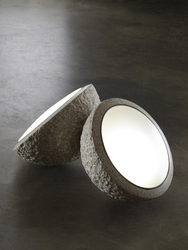Santa Fe, NM (PRWEB) April 7, 2009
Qnuru today launched a revolutionary line of solar powered, landscape lighting fixtures that efficiently capture the sun’s energy within expressive forms that are manufactured with full lifecycle sustainability in mind. Founded and designed by MacArthur award-winning sculptor Tom Joyce, Qnuru’s first solar lighting product line is aimed at addressing the increasing need by municipalities, businesses and consumers to reduce their reliance on fossil fuels and carbon footprint. Today, 22% of all electrical power generated in the world is used for lighting and 25% of this power is used for exterior lighting at an annual cost of $ 3.2 billion in the United States alone.
Housed in elegant, sculptural form factors, Qnuru’s products combine efficient LED technology, advanced solar engineering and integrated control systems to create an unparalleled lighting experience. Each lighting fixture is designed to illuminate architectural features, walkways and plantings; some are Dark Sky compliant with non-glare directional down lighting for parks, campuses, cityscapes and parking areas. Multiple digital microcontrollers provide intelligent power management and a full complement of features that can be custom selected and wirelessly programmed.
Qnuru products are engineered for strength and climate variability by using durable, quality materials and manufacturing methods and choices that include recyclable and renewable materials. Leveraging Joyce’s acclaimed ironwork expertise, structural elements derive their integrity from forged, cast or fabricated iron, cast or sheet aluminum, and carved stone. Translucent lenses that protect and conceal the photovoltaic array, the LEDs, and the reflective luminaries are fashioned from recycled cast, slumped or machined glass, high-impact (hail-proof) optical grade acrylic or natural mica sheet.
“To problem solve as an artist and a maker is for me, a daily responsibility,” said Tom Joyce, founder and head of design at Qnuru. “To imagine what is possible and then to bring together the most appropriate materials, processes and technology into useful yet uncommon lighting forms is at the heart of Qnuru’s mission. Worldwide, very few advancements have been made within the marketplace for high functioning, handsome solar lighting. Our self-contained solar powered lighting is created to positively address the need for more functionally elegant solutions for landscaped and architectural environments. Qnuru seeks to change the way solar lighting is implemented in our daily lives.”
About the Qnuru Product Line (More information at http://www.qnuru.com/products.html):
Turnabout is a solar powered landscape light with two matched hemispheres that pivot back to back. This functional rotation allows for precise orientation toward the sun. One hemisphere provides the solar collection surface concealed beneath a translucent lens; both hemispheres are lit with high output LED illumination. The control system and batteries are integrated within the units. The pair uses only 6 watts of power. An optional underground vault provides a secure foundation, mounting system and houses the batteries with an access hatch for occasional maintenance.
Talus is a solar powered landscape light consisting of 4 pairs of asymmetrical blocks cut from a cube of stone, or iron that has been sliced into 8 pieces along 3 offset intersecting perpendicular planes. The pairs sit back-to-back when installed. Both lights conceal a custom designed photovoltaic solar collection system behind translucent lenses. One must be positioned for optimum solar exposure and its mate can be placed to light in any direction. Our puzzle-like assemblage is intended to offer consumers playful choices in configuring the 8 individual lights into clustered compositions. Talus can also be ordered in a set of 2 individual lights. By incorporating ultra high-efficiency LED light engines, each unit consumes only 3 watts of power. An optional underground vault provides a secure foundation, mounting system and houses the batteries with an access hatch for occasional maintenance.
Cumuli is a suspended solar powered light in the form of amorphous, cloud-like shapes. This free-hanging fixture is designed for pedestrian plazas, parking lots, or streetscapes where large areas must remain open for foot and motor traffic. Cumuli can also be placed in multi-story indoor lobby spaces. Variations of the cloud forms are bisected horizontally with a metal plate that provides a mounting surface on top for solar cells and on the bottom for a battery compartment, luminaire and an LED harness. Cables are attached to the metal plate to suspend it overhead. The top lens is clear, high-impact acrylic and the bottom lens is translucent acrylic. Cumuli is designed to provide down light but upon request the top can be lit as well. Cumuli is available from 48-96 inches in length and is manufactured in a variety of materials and finishes.
Aquila is a solar powered pole lamp with 3 identical petals placed at varying heights to form a tree-like canopy. Solar cells are positioned on the top of each petal beneath a clear acrylic lens. Warm-light LEDs are mounted on the underside onto a highly reflective luminaire behind a translucent acrylic lens. By incorporating ultra high-efficiency LED light engines, each unit consumes between 25-50 watts of power. An underground vault provides a secure foundation, mounting system and houses the batteries with an access hatch for occasional maintenance. Aquila is manufactured in three sizes: 10′ high x 4′ diameter, 15′ high x 6′ diameter and 20′ high x 8′ diameter
About Tom Joyce:
Tom Joyce is an artist, designer and blacksmith who forges sculpture, architectural ironwork and public art for projects throughout the United States. For over 30 years he has freely shared his design concepts and working knowledge in lectures presented in Europe, Africa, the US and Canada. His work is in many public collections and has been exhibited in numerous museums internationally including the Museum of Arts and Design in New York, the Detroit and Minneapolis Institutes of Art, the Smithsonian Institution in Washington DC, the Boston Museum of Fine Art, the Museum for Kunsthandwerk in Frankfurt, the Museum of Applied Arts in Moscow, and the Mus

